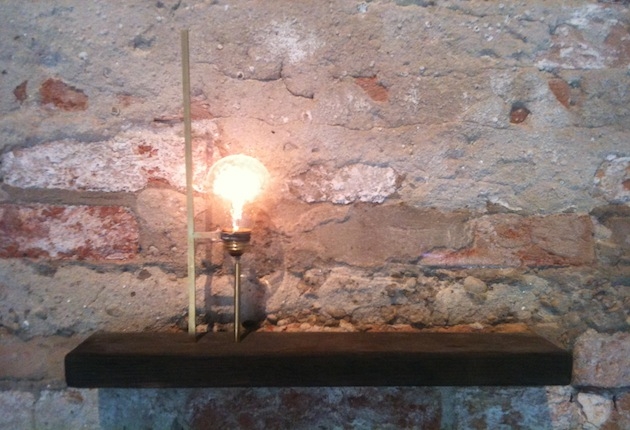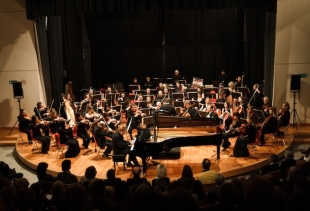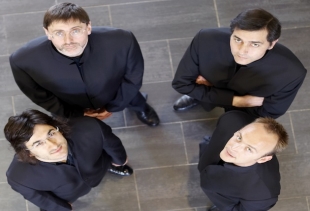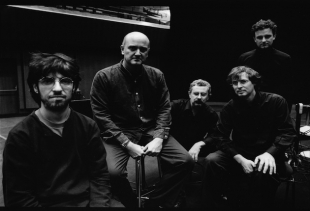» archive blog
-
Carnal, issue 0 of Parterre de Rois
A new magazine in Milandate: 18-07-2013
-
Interview with Nicola Toffolini
A worlds inventordate: 24-04-2011
-
Donne senza uomini.
Installazione multimediale di Shirin Neshatdate: 01-03-2011
56th Biennial of music in Venice: our feature and our day by day reviews
From 6 to October 13th, in Venice, there is the magical opportunity to listen to even 3 musical performances a day, including sonic installation and theatrical pieces: there is the 56th edition of Music Biennial curated by Ivan Fedele (Italian music composer and philosopher native of Lecce): the program is rich of 51 premieres, including 28 world premieres. We will follow +EXTREME- (this is the Biennale title) that will present some of the significant actors of these “excessive” practices, contextualized and examined in relation to the “classics” of radicalism: day by day we will publish the reviews of the concerts at which we have been accredited in this post, so please keep up reading, and reading again day by day this post.
Italian public radio channel Radio 3 is also transmitting in real time the major concerts (all the broadcasted ones are included in the free catalogue you can find in the main concerts venues: Teatro Piccolo, Teatro alla Tese, Ca’ Giustinian, Conservatorio, Fondazione Cini).
On the Biennale website (section Quarto Palcoscenico), after the event, a podcast library of many but not all the concerts will be online and free to listen: Ensemble Intercontemporain, Beneventi/ FVG Mitteleuropa Orchestra, Antony Braxton. Plus video interviews with all the authors of the section Meetings, such as, for example the Golden Lion Boulez, Bedrossian and Cendo.
The Music Biennial is the oldest festival after the Art Biennial - that we are following and reviewing, together with the Architecture one, since 2003; a good selection of our posts is permanently on our blog.
This edition Pierre Boulez [video] has been awarded with Golden Lion, while the Quartetto Prometeo with Silver Lion. The majority of the selected composers are alive and some of them are born after 1975 as for example Raphaël Cendo, devoted to saturation [video]. Many of them have been studying and researching at the important IRCAM or have been students of Luigi Nono and lots have been taken a masterclass in Italy (as well as are many the Italians we will review in the next days).
Many are the free entrance performances, especially those at Fondazione Cini and at Conservatorio of Venice, but many are also the reduced fares: beside special tickets and subscriptions for students, beside to special reduced tickets for diverse membership holders, we also remind that there are also 2 subscriptions available: the daily and full festival passes. Some sections, as the Sonic Garden at Tese alle Vergini (Arsenale) are free for Biennale di Architettura visitors).
Sunday October 7th, we listened to a special gig at Sala delle Colonne, the fab new venue into the Biennale headquarter few steps from Piazza San Marco and from the calle of Harry’s Bar. Daniel Quartet, born in Bruxelles on 1991 and know for its Shostakovich interpretations, has offered a program with living authors and one of the past century as: Yannis Xenakis, Pascal Dusapin, Karen Tanaka, Anton Webern.
Ergma (Yannis Xenakis, 1994, 9’) has a rare gift: a piece of only 9 minutes that has so much music inside that seems forever. It is cacophony recomposed and orchestrated by God.
The Quartet n.4 (Pascal Dusapin, 1997, 14’) caps the limit (from rumorista point of view) of the note and shake it, by let the hung executors making furious contrappunto, as they were contending each one. The bounces of their phrases create a concert, some like Berio but less severe and more mathematic. This quartet is as it seems: grated, an hive or reverberations that are first composed and then let explode. But it contains also reflections, introspections where are the basses together to short and barely un-audible silences to dominate.
With the Antoni Webern’s compositions (Cinque Movimenti per quartetto d’archi, op. 5, 1909, 8’; Langsamer Satz, 1905, 9’; Sei Bagatelle, 1910-13, 3’30’’) we reach the middle of Daniel Quartet program. The Cinque Movimenti are full of beats and nipping that are matching again the wideness of the note evolutions. More classical than the previous ones, the whole of the Cinque Movimenti is good but of the five, the second and the fourth are the more extraordinary, because are all set on levare and on laxity. This Webern’s work is hugely romantic and organic. It seems the movimenti have been stolen by hundreds of cinematic interludes. Sei Bagatelle is an intense collection of instants put in music – so fast that is hard to hear them.
Metal String (1996, 8’) by the enfant prodige Japanese composer Karen Tanaka is imperial, martial, hard as only the industrial rhythm can be (strong are the metal rock and electronic music influences in this piece). She has been taught at IRCAM as the half of the composer invited to this Biennale. Metal String crashes and re-ascend, it is – hoping the parallel will help you to imagine – like drum machine for arches (the implacable director for this piece has been overall the cello Guy Daniel).
The program could not have found a better end with again Xenakis and his Tetras (1983, 15’). It is psychedelic, ambient, complex and rich of sonic ideas that are heterogeneous and contrasting: the soul of a drummer, as Xenakis was, is touchable in this piece - the second violin and the viola are beating their instruments several time to follow the time. Even if it is not reaching the rumorista level, also in this Xenakis composition, the cords are reaching any possible tension and it will be not hard, for you, if you close the eyes by listening it, to perceive doors that are opening somewhere; yourselves fall down from Escher’s stairs; the green-blue imagination of infinite; old boats or old trains whistlings coming from somewhere; the long wings flapping during farewell. You will also feel like riding a roundabout going over the various western history times: from pre-Romanticism until Esistenzialismo.
Among performances hard to define of music (they could rightly stand in visual art festivals) we saw and listened to Simone Beneventi featuring One4 by John Cage (Cage is the author with more compositions plaid at Biennale). A small iron ball running in different bowls, a rusty petrol can and a coffee one, a nylon rope have been some of the instruments the Italian musician and composer picked up to respect Cage’s partition: to play with any instruments 8 strikes with the right hand and 8 with the left one. The last one has been given to a real, small drum.
Among the orchestras in the Festival, we enjoyed at Teatro alle Tese on Sunday 7th the FVG Mitteleuropa Orchestra, which has appeared in several recent editions. Superb has been the Italian premiere performance of Fachwerk by Sofija Gubajdulina, one of the greatest composers to emerge from the former Soviet Union, with her fragmented style interspersed with ethnic sounds, such as the bayan, originally a Russian instrument, considered an advanced version of the classic accordion (it has been electrified as a guitar, sometimes it worked as a synth, especially how has been used by the talented Germano Scurti). Another Italian premiere on Sunday has been the concert Initial by Polish composer Bettina Skrzypcak who also came on the stage to thanks the audience who appreciated a lot the piece: soft and at the same time strong, it was a creation of 2005 which expresses a great energy.
The Concerto for piano and orchestra by Cage, another piece in the program, is a perfect example of Cage’s un-determination: in addition to the composition technique based on the use of the I-Ching, the performer is also asked to agree on a tempo with the conductor (who at the premiere was a choreographer, Merce Cunningham) and on the overall length of the piece which includes the action of each musician, who are given 13 independent parts plus one for the pianist. “During the performance the pianist can play at any speed, any number of sheets, according to an equally indeterminate order, totally or partially as he wishes” (H.-K. Metzger). Percussions in this concert have been the whole and especially have been incredible also thanks to the characters of the orchestra: many musicians have also the role to beat their instruments to make also a count in the partition, who was not playing an instrument with a wooden structure was used to beat loud the foot on the floor. Closing piece of Sunday October 7th has been the world premiere AOiR by Franco-Argentine composer José Luis Campana which has been commissioned by French Government and dedicated to a series of rare small lizards: it tells of weak lights under the rivers or among the hills, with unexpected lamps and with, the same unexpected, moments of hid-and-seek.
On October 8th, Italian ensemble Alter Ego was starring – the young authors and musicians in the past were so proud of mixitè that put together the fascinating alchemies between composers (Glass, Kancheli, Hokosawa, Saariaho, Sciarrino), rappers (Frankie HI-NRG), singers, performers, electronic artists (Robin Rimbaud alias Scanner, Marco Passarani) and visual artists (as D-Fuse) – will turn the spotlight on the intensive presence of American composer Alvin Lucier – founder with Robert Ashle, David Behrman and Gordon Mumma of the legendary Sonic Arts Union in the Sixties – who, present, performed one of his most famous and paradigmatic pieces, I’m sitting in a room (a brief speech describing what happens, him sitting in a room and reading, re-sampled and repeated with machines until the words are disappearing in the sound) an example of ‘minimal tape music’, followed by pieces that all distil a single note or a single frequency in a sort of psycho-acoustic form: Three translations for Maurizio Mochetti, Fidelio Trio and the world premiere performance of a new creation for violin, cello, flute, clarinet and piano. On the same wavelength, but elaborated in a different way, is the music by Tristan Perich, composed with a single bit, then the music of Sean Friar is distinguished by its energetic and immediate “maximalism”. The very young Alter Ego they share the freedom with which they explore different musical experiences: each of them, apart from their academic training, boasts experiences in the field of free improvisation, noise, black metal, blues, rock, hard-core punk, and writes indifferently for ensembles of various origins, classical and not, so that their music has been performed in festivals such as Bang On A Can, Gaudeamus Muziekweek, Ars Electronica and Sonar, and in spaces such as the Lincoln Center, Carnegie Hall, and Whitney Museum.
Ivan Fedele was choosing the program of October 12 (6 pm) to be the only time in the theatre to introduce an upcoming concert, because it was fully dedicated at the 80th anniversary of the Italian composer Giacomo Manzoni (present at Teatro Piccolo) and has been issued with the collaboration of Mi/TO, a joint-venture brand and music festival happening in both the very close Northern Italy cities, the extraordinary designed Turin and the less brilliant Milan (at least in these times…). Ensemble Risognanze by Tito Ceccherini performed the extraordinary first world execution of Per questo (a duet for voice and trumpet) but the also interesting Alla Terra, Opus 75, Liriche di Élouard e Frase 2b, that has been alternated with two premieres of two other Italian composers: Giovanni Verrando and Alessandro Melchiorre.
The program of the day followed at Teatro alle Tese with the Stuttgard Radio Symphonic Orchestra that performed a first time in Italy listened piece by Christhope Bertrand, this was his last composition before the artist died at the early age of 29. Piece has been titled by subverting the surname of the artist Rothko (Okthor). Directed by Michel Tabachnik, who also worked with Berio, Stockhausen, Ligeti, Meassiaen and has been the best interpreter for Xenakis, the concert also offered a classic piece as La mer by Claude Debussy, the first time performer in Italy Le cri de Mohim, Premier tableau de la Legende de Haïsh, written by Tabachnick and also Concerto by Rune Glerup.
56th Music Biennale ended yesterday, Saturday October 13 (Foundation La Biennale Spa informed that public augmented of 61% and that more than 1000 have been students benefiting of the special educational programs): I will really wait with interest to discover the program of the next one that will happen on 2014. How could I end usefully this post? With the direct link to Quarto Palcoscenico, the archive of Biennial for podcast and video of this edition and some performances recently held in the involved spaces.
http://www.labiennale.org/it/mediacenter/quarto_palcoscenico/




